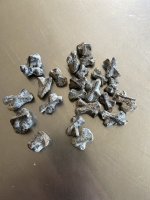Brendan M.
Hero Member
- Apr 14, 2006
- 649
- 10
- Detector(s) used
- White's DFX, Bullseye II pinpointer, Gray Ghost Headphones
- Primary Interest:
- All Treasure Hunting
I have a question about the site I'm digging:
I'm working an old park that was super-busy in the mid-1800s. Lots of structures once stood where there are now just open fields and baseball diamonds. I've got a few spots that seem definitely promising, and one in particularly turned up two large cents the first time I hunted it, just the other day. So I'm encouraged.
Here's my question: It seems once you dig about 4-5 inches down (where I found the large cents as well as some iron relics), there's a pretty consistent layer from there of red brick and pottery shards, broken glass and TONS of clam shells. What's the deal with the shells? Are they the remains of Victorian-era clambakes or something? Garden fertilizer? Mind you, I live by the ocean, and even I'm a little surprised by just how many shells are buried there.
Any insight would be great.
Thanks!
--B
I'm working an old park that was super-busy in the mid-1800s. Lots of structures once stood where there are now just open fields and baseball diamonds. I've got a few spots that seem definitely promising, and one in particularly turned up two large cents the first time I hunted it, just the other day. So I'm encouraged.
Here's my question: It seems once you dig about 4-5 inches down (where I found the large cents as well as some iron relics), there's a pretty consistent layer from there of red brick and pottery shards, broken glass and TONS of clam shells. What's the deal with the shells? Are they the remains of Victorian-era clambakes or something? Garden fertilizer? Mind you, I live by the ocean, and even I'm a little surprised by just how many shells are buried there.
Any insight would be great.
Thanks!
--B
Upvote
0



 Have you been out hunting on LI before?
Have you been out hunting on LI before?
